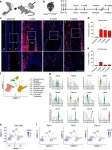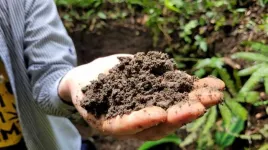(Press-News.org) Many of the answers for effectively responding to a pathogen lie in its genome. Understanding the genetic code of a pathogen like Ebola or the virus that causes COVID-19 allows scientists to track its movement, predict future behavior, identify the source of the outbreak and, most importantly, develop effective vaccines and treatments. This technology was critical during the pandemic, and it will be even more so with future outbreaks.
That makes the continued development of genomic sequencing one of the most important takeaways from the pandemic, argue biologists Jason Ladner and Jason Sahl in an essay published in PLOS Biology. Genomic sequencing had a huge impact in the global response to COVID-19, and the technology improved as more researchers put it to use. To better respond to the next pandemic, we need to build on that knowledge, they write, while also recognizing the gaps in our capabilities that remain.
“The COVID-19 pandemic in many ways represented the culmination of sequencing and analysis that had been building for years,” Sahl said. “We wanted to highlight that although interest in the pandemic has waned, other threats still exist, and maintaining our momentum while also building new infrastructure will be vital for improving public health responses to existing and emerging threats.”
Why the history matters to the present and future
Ladner and Sahl, associate professors in the Department of Biological Sciences at Northern Arizona University, and their colleagues in the Pathogen & Microbiome Institute, are on the front lines of applying and analyzing cutting-edge genomic technology in the study of pathogens, and have worked with various infectious agents, including Ebola, Zika, Yersinia pestis (which causes plague), anthrax and Burkholderia pseudomallei (which causes melioidosis).
In the essay, they focus on the history of pathogens and genomic sequencing to help readers understand that the patterns we see now aren’t new. In the 1960s, scientists thought they had infectious disease resolved with the development of vaccines, antibiotics, personal hygiene and sanitation norms and more.
“What we did not fully appreciate at the time, however, was the incredible diversity of human pathogens, their capacity for rapid evolution and the dynamic nature of interactions between pathogens and their hosts,” Ladner and Sahl write. “Combined, these factors have substantially complicated our attempts to mitigate the impacts of infectious disease.”
Sixty years later, pathogens remain complicated. The biologists provide a roadmap for various stakeholders in preparation for the next pandemic: highlighting deficits in research for scientists to address; pointing out the critical need for collaboration and investment for policymakers; and explaining the history of pathogen genomic sequencing to public health officials, media, philanthropists and others so they can understand the full potential of pathogen sequencing for public health.
“We wrote this essay to contribute to the broader discussion of how pathogen genome sequencing should be used in the future to improve public health and what types of investments and innovations we need to facilitate this,” Ladner said. “This is no longer a niche topic, but one with broad appeal for scientists in multiple different fields, officials setting health care policy and media who are working to understand recent advances and communicate them to the general public.”
Lessons learned from the COVID-19 pandemic
We need better infrastructure. The biggest deficit is a lack of global infrastructure to support real-time sequencing and collaboration among countries and among different research institutions. Some of this was built during the pandemic, but scientists also identified deficits in sequencing capacity and data sharing, which means they’re working with an incomplete picture of what is happening on the ground. This will require sustained investments between stakeholders.
We need to expand the way we use pathogen genomes in our response to infectious disease. This is a science problem, but it’s also much bigger than that. “To realize the full public health potential of pathogen sequencing in the future, we need to harness the momentum generated by the COVID-19 pandemic while ensuring that the benefits of future investments apply broadly to the full spectrum of human infectious disease,” Ladner said.
We need to define objectives for the role of pathogen genomics in responding to public health threats. With COVID, scientists used genomes the best they could, but in most cases, they haven’t had clear objectives for how genomes should contribute to a public health response. Defining those objectives will help researchers plan for future outbreaks and evaluate the effectiveness of the response.
We have to keep the momentum going. Although COVID-19 remains a threat, interest in the pandemic has faded. However, antimicrobial resistance still represents a significant public health threat. The sequencing infrastructure built during the pandemic will need to be supported by sustained federal investments, or society will return to pre-pandemic capacity and will be unable to quickly respond to the next public health threat, Sahl said.
END
The key to battling a pathogen hides in its genome
Two biologists argue that building on this momentum is critical in society’s response to future pandemics, but it requires significant collaboration and investment now, before the next pathogen is threatening society
2023-08-01
ELSE PRESS RELEASES FROM THIS DATE:
Scientists develop breath test that rapidly detects COVID-19 virus
2023-08-01
Scientists at Washington University in St. Louis have developed a breath test that quickly identifies those who are infected with the virus that causes COVID-19. The device requires only one or two breaths and provides results in less than a minute.
The study is available online in the journal ACS Sensors. The same group of researchers recently published a paper in the journal Nature Communications about an air monitor they had built to detect airborne SARS-CoV-2 — the virus that causes COVID-19 — within about ...
Sex pheromone of moths is a precise mix of ingredients
2023-08-01
Researchers from the UvA and North Carolina State University have identified the specific mixture of pheromone chemicals that male moths use during courtship. The findings provide more detail about the complex blend of chemicals that males and females of this group of moths use in fundamental short-range communication. The publication in the scientific journal Current Biology appeared on 1 August.
Scent compounds are essential for male moths to entice female conspecifics to mate. Both partners need to find and recognize each other in the dark. This is done by sex pheromones secreted by the female. Then it is up to the male to convince the female ...
Study characterizes unique immune response in patients who experience inflammatory arthritis as side effect of cancer therapies
2023-08-01
Immune checkpoint inhibitor (ICI) therapies used to treat cancer come with the risk of adverse autoimmune responses, including arthritis that can persist for years and require joint replacement surgery. Little is known about the specific cells responsible for these events. Researchers at Brigham and Women’s Hospital, a founding member of the Mass General Brigham healthcare system, and collaborators led a study to investigate these immune adverse events and identified a specific type of CD8 T cell that characterizes inflammatory arthritis induced by ICI therapies.
Researchers ...
Three doses of COVID-19 vaccine leads to catch-up antibody responses among the particularly vulnerable
2023-08-01
Even vulnerable people, who are at risk of severe Covid-19, achieved good antibody levels after three doses of mRNA vaccine. This is shown by a study from the University of Gothenburg on patients having undergone a bone marrow transplant or with liver disease, including cirrhosis.
The aim of the study, which has been published in the journal Infectious Diseases, was to investigate the effects of repeated vaccinations and hybrid immunity against Covid-19 among particularly vulnerable individuals. Hybrid immunity refers to the protection provided by vaccination in combination with SARS-CoV-2 ...
UCSF Medical Center is among nation’s top hospitals for 2023-24
2023-08-01
UCSF Medical Center Is Among Nation’s Top Hospitals for 2023-24
U.S. News & World Report ranks UCSF Health adult care among nation’s top 10 hospitals in 7 specialties, Best in the West for neurology/neurosurgery and rheumatology
UCSF Medical Center has been named to the Honor Roll of the nation’s top hospitals for adult care in U.S. News & World Report’s 2023-24 Best Hospitals rankings, representing the highest quality of care and safety standards in the country.
The distinction was earned by only 22 medical ...
Immigrant nurses in long-term care facilities often have more “human capital” compared to American-born nurses, MU researcher finds
2023-08-01
COLUMBIA, Mo. -- When assessing the skills and competencies or “human capital” of long-term care registered nurses in the United States, studies often focus solely on years of experience and traditional educational backgrounds. However, a new study conducted by a nurse scientist now at University of Missouri found that by incorporating additional criteria, such as ability to speak multiple languages, additional certificates or trainings and licenses to practice in multiple states, immigrant nurses often represent far more human capital than their American-born counterparts.
Roy Thompson, a postdoctoral fellow in the MU Sinclair School of Nursing ...
New insights into heterotopic ossification: Progenitor cells play a key role in aberrant bone formation
2023-08-01
In a new study published on 21 July 2023 by the journal Bone Research, a team of researchers from Johns Hopkins University, using a combination of lineage tracing and single-cell RNA sequencing (scRNA-seq), delved into the contribution of synovial/tendon sheath progenitor cells to heterotopic bone formation. The researchers identified a distinct population of Tppp3+ tendon progenitor cells that actively participated in the formation of ectopic bone in vivo. Their findings provide new insights into the intricate cellular processes driving heterotopic ossification and offer potential therapeutic targets to prevent and ...
Where Black adolescents live affects their mental health
2023-08-01
It’s easy to imagine that growing up in a neighborhood with safe and clean parks, little to no discrimination, and where people are not struggling financially makes for a lower-stress childhood. In contrast, neighborhoods with few community spaces, violence, and poverty create a higher-stress environment for a child to live in. Unfortunately, systemic and structural issues such as wealth inequality, residential segregation, barriers to home ownership, and environmental injustice in neighborhoods where Black American adolescents disproportionately reside make ...
Amazon dark earth boosts tree growth as much as sixfold
2023-08-01
A type of soil called terra preta da Amazônia, or Amazon dark earth (ADE), promotes faster growth of trees and enhances their development in qualitative terms, according to an article published in the journal Frontiers in Soil Science.
The findings reported in the article resulted from studies supported by FAPESP (projects 20/08927-0, 18/19000-4 and 14/50320-4) under the aegis of its Biodiversity, Characterization, Conservation, Restoration and Sustainable Use Program (BIOTA).
“ADE is rich in nutrients and supports communities of microorganisms that help plants grow, among other things. Native people of the Amazon have ...
Sweet smell of success: Simple fragrance method produces major memory boost
2023-08-01
Irvine, Calif., Aug. 1, 2023 — When a fragrance wafted through the bedrooms of older adults for two hours every night for six months, memories skyrocketed. Participants in this study by University of California, Irvine neuroscientists reaped a 226% increase in cognitive capacity compared to the control group. The researchers say the finding transforms the long-known tie between smell and memory into an easy, non-invasive technique for strengthening memory and potentially deterring dementia.
The team’s study appears in Frontiers in Neuroscience. ...
LAST 30 PRESS RELEASES:
Making lighter work of calculating fluid and heat flow
Normalizing blood sugar can halve heart attack risk
Lowering blood sugar cuts heart attack risk in people with prediabetes
Study links genetic variants to risk of blinding eye disease in premature infants
Non-opioid ‘pain sponge’ therapy halts cartilage degeneration and relieves chronic pain
AI can pick up cultural values by mimicking how kids learn
China’s ecological redlines offer fast track to 30 x 30 global conservation goal
Invisible indoor threats: emerging household contaminants and their growing risks to human health
Adding antibody treatment to chemo boosts outcomes for children with rare cancer
Germline pathogenic variants among women without a history of breast cancer
Tanning beds triple melanoma risk, potentially causing broad DNA damage
Unique bond identified as key to viral infection speed
Indoor tanning makes youthful skin much older on a genetic level
Mouse model sheds new light on the causes and potential solutions to human GI problems linked to muscular dystrophy
The Journal of Nuclear Medicine ahead-of-print tip sheet: December 12, 2025
Smarter tools for peering into the microscopic world
Applications open for funding to conduct research in the Kinsey Institute archives
Global measure underestimates the severity of food insecurity
Child survivors of critical illness are missing out on timely follow up care
Risk-based vs annual breast cancer screening / the WISDOM randomized clinical trial
University of Toronto launches Electric Vehicle Innovation Ontario to accelerate advanced EV technologies and build Canada’s innovation advantage
Early relapse predicts poor outcomes in aggressive blood cancer
American College of Lifestyle Medicine applauds two CMS models aligned with lifestyle medicine practice and reimbursement
Clinical trial finds cannabis use not a barrier to quitting nicotine vaping
Supplemental nutrition assistance program policies and food insecurity
Switching immune cells to “night mode” could limit damage after a heart attack, study suggests
URI-based Global RIghts Project report spotlights continued troubling trends in worldwide inhumane treatment
Neutrophils are less aggressive at night, explaining why nighttime heart attacks cause less damage than daytime events
Menopausal hormone therapy may not pose breast cancer risk for women with BRCA mutations
Mobile health tool may improve quality of life for adolescent and young adult breast cancer survivors
[Press-News.org] The key to battling a pathogen hides in its genomeTwo biologists argue that building on this momentum is critical in society’s response to future pandemics, but it requires significant collaboration and investment now, before the next pathogen is threatening society




